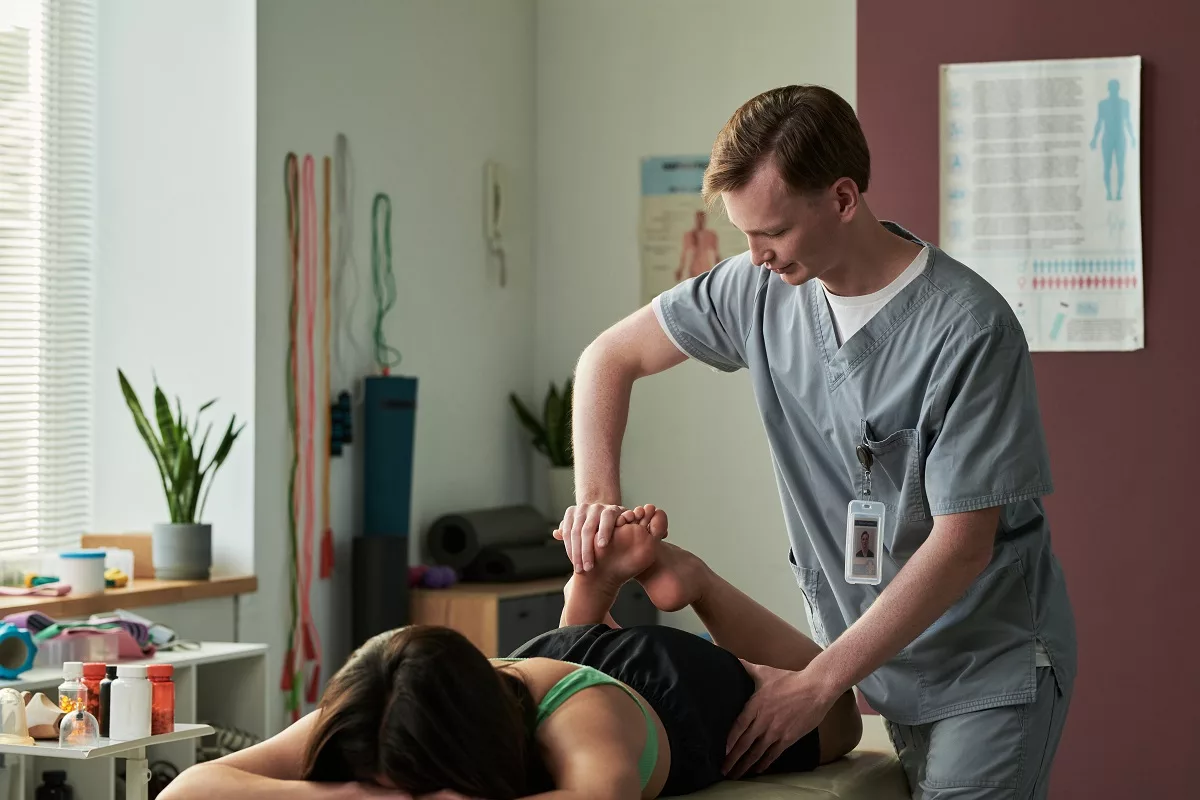A health condition that causes pain, numbness, and tingling along the pinched nerve in the back is called radiculopathy. In general, doctors have divided this disorder into 3 types. For example, cervical, thoracic, and lumbar. The type you develop depends on the location of the pinched nerve.
In most cases, people get rid of radiculopathy symptoms with posture improvements, over-the-counter medications, and physical therapy exercises. In other words, this condition often improves without treatment at all.
Sometimes, people do not understand the difference between radiculopathy and myelopathy, spondylolysis, and sciatica. Check below them in detail:
Radiculopathy and Myelopathy
While both are painful disorders that negatively affect the spine, radiculopathy often occurs temporarily and does not cause serious health problems. However, myelopathy occurs when the spinal cord is compressed due to trauma, tumor, degenerative disease, or infection. Moreover, if you leave this condition untreated, it may gradually worsen over time and cause permanent damage to the nerves. That’s why if you experience back pain that lasts more than 1-2 weeks, you should visit a doctor for diagnosis.
Radiculopathy and Spondylolysis
A condition in which the bones that make up the spine become weak is called spondylolysis. It may cause small stress fractures that often cause pain in the lower back. Sometimes, it may occur in teenagers who go through growth spurts.
Radiculopathy and Sciatica
While both disorders occur due to a pinched nerve, the difference between them is the type of nerves that are pinched and cause pain. For instance, in people with radiculopathy, the nerve that goes along the spine is compressed or irritated, but in people with sciatica, the pain is caused by irritation of the sciatic nerve. It is the longest nerve in the body, and it begins in the lower back and goes down the legs.
In general, radiculopathy occurs quite rarely. Moreover, the most common problems include neck, back, and lower back pain, but they are rarely caused by this disorder.
How Does Radiculopathy Affect My Body?
While the primary symptom is pain, in severe cases, it may also cause other symptoms around the pinched nerve, especially when you try to sit, stand, or move. One example is cervical radiculopathy, which makes it painful and difficult to move the neck.
Symptoms
Usually, the symptoms occur differently among people with radiculopathy because it depends on which type you develop. For example:
- Cervical radiculopathy – Those who develop this type of condition may experience pain and other symptoms around the neck. Other symptoms often spread to the arms and hands.
- Thoracic radiculopathy – This type usually causes pain in and around the chest (including when you are breathing).
- Lumbar radiculopathy – In such cases, pain occurs in the lower back and may radiate to the legs. Sometimes, people may also experience numbness.
However, people may also experience other symptoms along with pain. Check below some general symptoms of radiculopathy:
- Pain in and around the affected nerve
- Numbness
- Tingling
- Muscle weakness
There are multiple health conditions that can cause previous symptoms. Thus, if you experience any of the previous symptoms, you should see a doctor for diagnosis and treatment.
Causes
Usually, radiculopathy occurs when something irritates or compresses the roots of spinal nerves. For example:
- Bone spurs (usually occur on growing vertebrae)
- A herniated disc
- Trauma (including car accidents, falls, and others)
Sometimes, people may develop this condition due to aging without a direct cause. It occurs because the bones and disks in the spine lose their flexibility and shape. This is a natural degeneration and weakening process that occurs in older adults (over 60 years old).
What Happens if Radiculopathy is Left Untreated?
People with this condition may also experience some complications if they leave it untreated. Check below some examples:
- Chronic pain
- Muscle weakness and atrophy
- Numbness or altered sensations
- Loss of function
- Mental health problems (such as depression, anxiety, and others)
- Weight gain
- Cauda Equina syndrome – This is a serious health condition in which nerve roots at the end of the spinal cord are compressed. Without treatment, it may lead to loss of bowel or bladder control, severe numbness in the pelvic region, and progressive weakness in the legs.
This document does not contain a complete list of radiculopathy complications. You can also consult with your physician about ways to reduce the risk of developing previous complications.
Moreover, multiple causes of this condition cannot be prevented. That’s why it is recommended to maintain good spine health and posture.
Diagnosis
Usually, doctors begin the diagnosis with a physical examination and questions about the symptoms and medical history. However, to confirm this condition, you may need one of the following imaging tests. Check below some examples:
- X-ray – This test is often used to detect narrowing and changes in alignment of the spinal cord and spinal fractures.
- CT (computed tomography) scans – Doctors often perform this test to get cross-sectional images of the spine.
- MRI (magnetic resonance imaging) – This test uses a powerful magnetic field and radio waves to make detailed images of different structures and organs in the body. In such cases, it may help identify damage to soft tissues that cause nerve compression.
- Electromyography (EMG) – It is primarily used to measure electrical impulses in the muscles. It helps determine if nerves work properly and your symptoms are caused by spinal nerve roots or another disorder (such as diabetes).
Treatment
The treatment is often different for people who develop radiculopathy. It depends on the severity and type of the condition, the exact location of the compressed nerve, existing health problems, age, and preferences. Moreover, some people do not need treatment because the symptoms improve on their own within a few days or weeks. Check below some tips that may speed up healing if you do not need treatment:
- Heat or ice – Your doctor may recommend applying heat or ice to your back to reduce swelling and relax muscles.
- Physical therapy or adjusting posture – This therapy involves specific exercises that target the areas around the spine. They often help relieve pressure on the nerves and pain. Furthermore, improving overall posture may reduce stress on the spine and ease the symptoms.
However, when previous options do not help reduce inflammation and pain, physicians may also recommend some medicines. For example:
- Over-the-counter (OTC) NSAIDs – This group of medicines is used to relieve the symptoms caused by radiculopathy. Doctors often recommend Ibuprofen or Aspirin.
- Corticosteroids – If you experience moderate to severe pain, doctors may recommend Prednisone. This medicine can be taken orally as pills or injected into the affected area of the back.
Surgery
This treatment is rarely recommended by doctors for people with radiculopathy. Usually, it is prescribed when a person experiences severe symptoms as they interfere with daily activities. For more details, discuss it with your doctor.
Frequently Asked Questions
How soon after treatment will I feel better?
Most people begin to feel better within several days after starting the treatment. In some cases, it may take a few weeks.
When should I go to the ER?
Immediately call 911 or go to the nearest emergency room (ER) if you cannot move your hands, arms, legs, or neck after a trauma.
Is radiculopathy curable?
In general, most people with radiculopathy can be cured with appropriate treatment. Commonly, this condition is treated with physical therapy and medicines. Ask your healthcare provider if you have additional questions.




